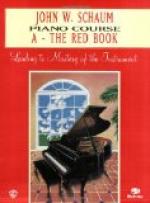“I was something of a wonder child, and at an early age developed considerable facility and brilliancy. After knocking about as a pupil of various private teachers and conservatories, I became, while quite a young lad, the pupil of de Konstki, then a lion of the day.” The speaker joined in the laugh his remark called up, which brought to mind the Chevalier’s famous battle-horse, “The Awakening of the Lion.”
“De Konstki’s style was very brilliant and I endeavored to imitate him in this respect. I did quite a little concert work at that time. Realizing, however, that a pianist’s income must be rather precarious, I decided to teach. In those youthful days I had the idea that the teacher of the piano had an easy life. I remembered one of my professors, a man of considerable reputation, who took the duties of his profession very lightly. His method of giving a lesson was to place the music upon the piano, start the pupil going, then retire to a comfortable couch, light his pipe and smoke at ease, troubling himself little about the pupil’s doings, except occasionally to call out ‘Falsch!’
“So I, too, began to teach the piano. But I soon discovered that teaching was something quite different from what I had imagined it to be, and that it was something I knew very little about. I now set myself to learn how to teach—how to help those pupils who came to me.
“One of my first discoveries was that most of the pupils were afflicted with stiff wrists and arms, and that this stiffness must be remedied. My own playing had always been free, due to one of my early teachers having thoroughly inculcated the principle of ‘weight,’ so often acclaimed in these days as a modern discovery. But how to bring about this condition in others was a great problem. I studied the Mason method, and found many helpful, illuminating ideas in regard to relaxation and devitalization. I had some lessons with S.B. Mills, and later did considerable valuable work with Paolo Gallico, who opened up to me the great storehouse of musical treasure, and revealed to me among other things the spiritual technic of the pianist’s art. Subsequently I investigated the Virgil and Leschetizky methods. Mr. Virgil has done some remarkable things in the way of organizing and systematizing technical requirements, and for this we owe him much. Such analyses had not before been made with anything like the care and minuteness, and his work has been of the greatest benefit to the profession. My subsequent studies with Harold Bauer revealed him to be a deep musical thinker and a remarkable teacher of the meaning of music itself.
“In my teaching I follow many of the ideas of Leschetizky, modified and worked out in the manner which I have found most useful to my own technic and to that of my pupils. I have formulated a method of my own, based on the principles which form a dependable foundation to build the future structure upon. Each pupil at the outset is furnished with a blank book, in which are written the exercises thus developed as adapted to individual requirements.




